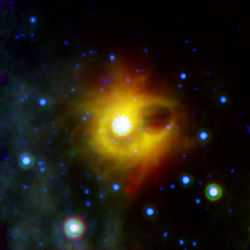SGR 1900+14
 SGR 1900+14 | |
| Observation data Epoch J2000 Equinox J2000 | |
|---|---|
| Constellation | Aquila |
| Right ascension | 19h 07m 16.85s |
| Declination | +09° 18' 50.4"' |
| Characteristics | |
| Variable type | Gamma ray burst |
| Astrometry | |
| Distance | 20 kly (6.1 kpc) |
| Details | |
| Mass | ? M☉ |
| Rotation | 5.2[1] |
| Other designations | |
| Database references | |
| SIMBAD | data |
| Data sources: | |
| Hipparcos Catalogue, CCDM (2002), Bright Star Catalogue (5th rev. ed.) | |
SGR 1900+14 is a soft gamma repeater (SGR), located in the constellation of Aquila about 45,000 light-years away. It is assumed to be an example of an intensely magnetic star, known as a magnetar, but it could also be a super-magnetic quark star. It is thought to have formed after a fairly recent supernova explosion.
An intense gamma-ray burst from this star was detected on August 27, 1998; shortly thereafter a new radio source appeared in that region of the sky.[2]
NASA's Spitzer Space Telescope detected a mysterious ring around SGR 1900+14 at two narrow infrared frequencies in 2005 and 2007. The 2007 Spitzer image showed no discernible change in the ring after two years. The ring measures seven light-years across. The origin of the ring is currently unknown and is the subject of an article in the May 29, 2008 issue of the journal Nature.[3]
See also
References
- ↑ Kaspi, Victoria (August 26–29, 2002). "Magnetars". Radio Pulsars. Crete: Astronomical Society of the Pacific. pp. 151–158.
- ↑ NRAO, New Evidence of Particle Injection by a Magnetar
- ↑ Newswise: CSI: Milky Way Team Works Scene of Dead Star
External links
Coordinates: ![]() 19h 07m 16.85s, +09° 18′ 50.4″
19h 07m 16.85s, +09° 18′ 50.4″
| |||||||||||||||||||||||||||||